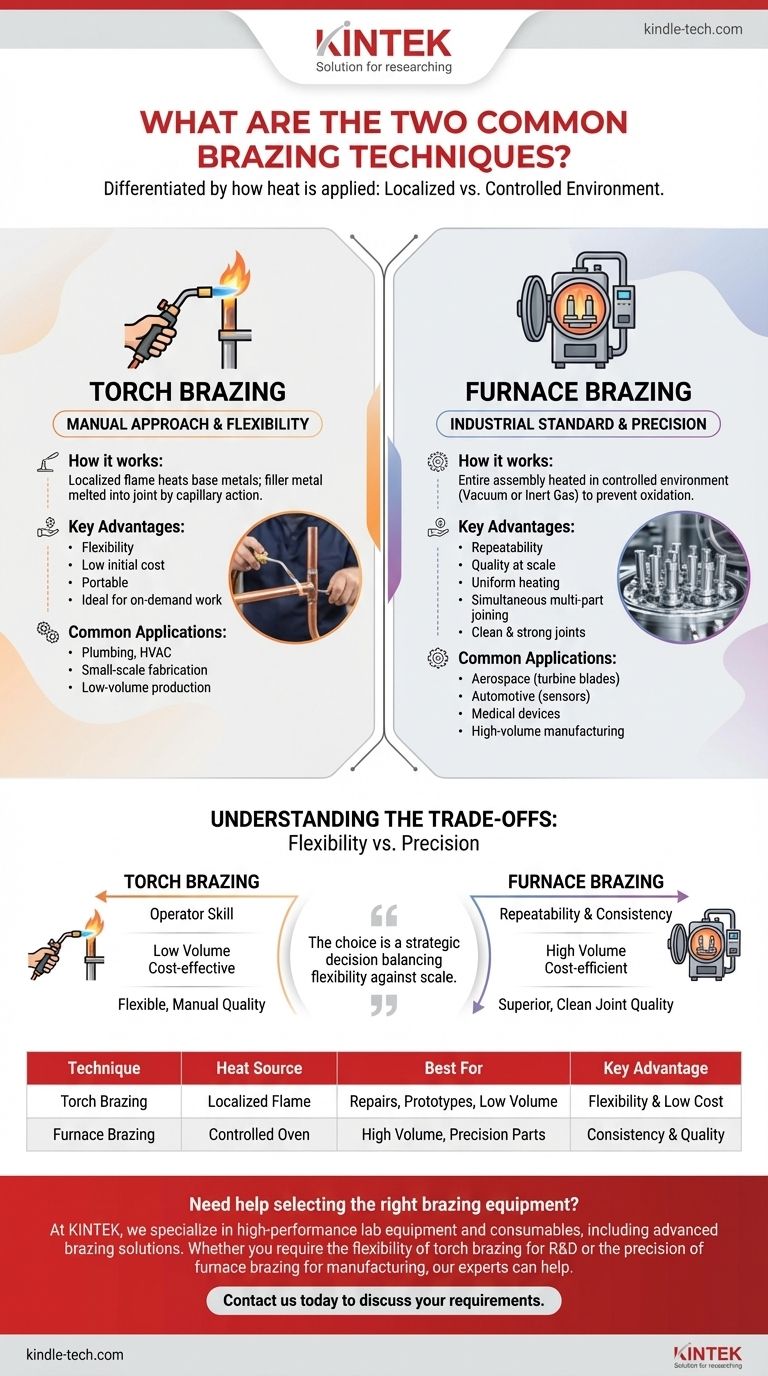At its core, brazing is differentiated by how heat is applied. The two most common and fundamentally different techniques are torch brazing, which uses a localized flame, and furnace brazing, which heats the entire assembly in a controlled environment. While other methods exist, these two represent the primary approaches for everything from simple repairs to mass-produced industrial components.
The choice between torch and furnace brazing is a strategic decision balancing flexibility against scale. Torch brazing provides on-demand, portable joining for low-volume work, while furnace brazing delivers superior consistency and quality for high-volume, precision manufacturing.

Understanding Torch Brazing: The Manual Approach
Torch brazing is the most recognizable form of the process, often performed manually by a skilled operator. It uses a fuel gas (like acetylene or propane) mixed with oxygen or air to create a high-temperature flame.
How It Works
The operator directs the flame to heat the base metals of the parts being joined. Once the assembly reaches the correct temperature, the filler metal is touched to the joint, where it melts and is drawn into the gap by capillary action.
Key Advantages
This method's primary advantage is its flexibility and low initial cost. There is no need for a large, expensive furnace, and the equipment is portable, making it ideal for repairs in the field or for one-off prototypes.
Common Applications
Torch brazing is the go-to technique for plumbing, HVAC system installation and repair, and small-scale fabrication shops. It is best suited for low-volume production where manual control is a benefit, not a bottleneck.
Understanding Furnace Brazing: The Industrial Standard
Furnace brazing involves placing the components, with the filler metal pre-placed at the joints, into a furnace. The entire assembly is then heated to the brazing temperature in a controlled environment.
How It Works
The controlled environment is the key. This is often a vacuum or an atmosphere of inert gas. This prevents the oxidation of the parts during heating, resulting in extremely clean and strong joints without the need for flux. The references provided focus heavily on vacuum brazing, a premier type of furnace brazing.
Key Advantages
The main benefits are repeatability and quality at scale. Because the heating is uniform and computer-controlled, every part comes out identical. It also allows for hundreds or thousands of parts to be brazed simultaneously and enables the joining of complex assemblies with multiple joints.
Common Applications
This is the standard for high-volume, critical industries. As noted in the references, furnace brazing is essential in aerospace (turbine blades, heat exchangers), automotive (sensors, fuel injectors), and medical devices (surgical instruments, implants).
Understanding the Trade-offs: Flexibility vs. Precision
Choosing the right technique requires understanding the fundamental compromises between the two methods.
Skill vs. Repeatability
Torch brazing is highly dependent on operator skill. The quality of the joint is determined by the operator's ability to heat the part evenly and apply the filler correctly. Furnace brazing removes this variable, offering unmatched consistency from part to part.
Production Volume and Cost
For a single part or a small batch, torch brazing is far more cost-effective due to the low setup cost. However, for mass production, the high throughput of furnace brazing makes the per-unit cost significantly lower, easily justifying the initial investment.
Joint Quality and Cleanliness
Furnace brazing, particularly vacuum brazing, produces a superior joint. Heating in a vacuum or controlled atmosphere eliminates oxides, leading to stronger, more reliable, and cleaner joints that often require no post-braze cleaning.
Making the Right Choice for Your Goal
Your project's requirements will dictate the correct brazing technique.
- If your primary focus is rapid prototyping, repair, or low-volume work: Torch brazing offers the necessary flexibility and low upfront cost.
- If your primary focus is high-volume manufacturing of identical parts: Furnace brazing delivers the repeatability and per-unit cost efficiency required for production at scale.
- If your primary focus is achieving the highest possible joint strength and cleanliness for critical parts: Vacuum furnace brazing is the definitive choice for demanding applications.
Ultimately, selecting the right brazing method is about aligning the heating technique with your project's specific goals for scale, precision, and performance.
Summary Table:
| Technique | Heat Source | Best For | Key Advantage |
|---|---|---|---|
| Torch Brazing | Localized Flame | Repairs, Prototypes, Low Volume | Flexibility & Low Cost |
| Furnace Brazing | Controlled Oven | High Volume, Precision Parts | Consistency & Quality |
Need help selecting the right brazing equipment for your laboratory or production line? At KINTEK, we specialize in high-performance lab equipment and consumables, including advanced brazing solutions. Whether you require the flexibility of torch brazing for R&D or the precision of furnace brazing for manufacturing, our experts can help you achieve superior joint quality and efficiency. Contact us today to discuss your specific brazing requirements!
Visual Guide

Related Products
- Vacuum Heat Treat Sintering Brazing Furnace
- Molybdenum Vacuum Heat Treat Furnace
- 2200 ℃ Graphite Vacuum Heat Treat Furnace
- 2200 ℃ Tungsten Vacuum Heat Treat and Sintering Furnace
- Vacuum Heat Treat Furnace with Ceramic Fiber Liner
People Also Ask
- What are the different types of brazing welding? A Guide to Choosing the Right Heat Source
- What is a vacuum furnace used for? Unlock Purity in High-Temperature Processing
- Can dissimilar metals be brazed or braze welded? A Guide to Strong, Reliable Joints
- What is the cost of a vacuum brazing furnace? A guide to key factors and investment strategy
- What is vacuum brazing? The Ultimate Guide to High-Purity, Flux-Free Metal Joining



















